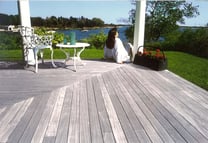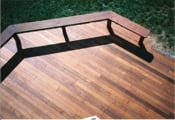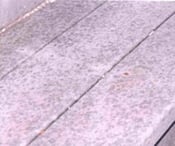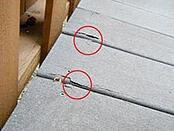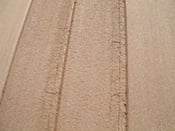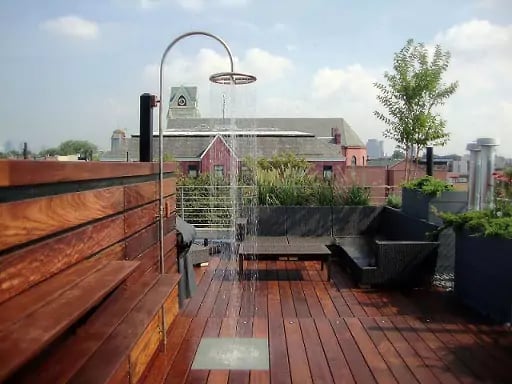
COMPARE DIFFERENT TYPES OF WOOD DECKING MATERIALS
Which Decking Material is Right for You?
Wood Decking or Composite Decking?
Wood decking has been a popular decking material since the days of covered front porches and evening strolls in the late 1800's. From the old style 1x4 tongue and groove fir porch flooring of this golden era, to the more durable decking material options of modern times, there is no shortage of wood decking options. Even the composite decking and plastic decking options try to emulate the look of real wood decking.
Making the right selection for your decking material is a decision you will live with for years to come. Learn more about material options and make the decision that is just right for you. There are so many different types of decking material options, it can be be confusing.
Whether your project is a backyard deck, walkway, bridge, pergola, gazebo, dock, rooftop recreation area, or a world famous boardwalk, see how Mataverde® Premium Hardwood Decking compares to other material options.
Mataverde high density hardwood decking is the reliable and sustainable material option that will last, beautifully, for many years to come. All of Mataverde Premium Hardwood Decking products are all natural, responsibly harvested and naturally resistant to insect damage and decay.
Take a closer look at some of the stunning variations and natural attributes of the woods themselves and you'll understand why with Mataverde Premium, you are one step closer to the deck of your dreams.
Want a free resource for comparing all your deck board options?
Download the "Ultimate Guide to Selecting The Right Decking" now.
HARDWOOD DECKING MATERIAL OPTIONS
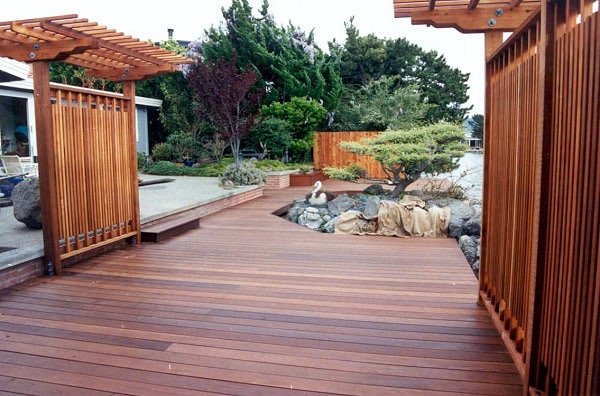 High density hardwood materials offer architects, designers, builders and owners an all-natural, sustainably-harvested, long-lasting option for outdoor projects of all types. The durability and natural beauty of Ipe, Cumaru, Garapa, Jatoba (Brazilian Cherry), Machiche and other hardwood decking materials can be selected to bring your project dream to reality. Using a tropical hardwood for your deck is a great way to add natural beauty and durability to your project.
High density hardwood materials offer architects, designers, builders and owners an all-natural, sustainably-harvested, long-lasting option for outdoor projects of all types. The durability and natural beauty of Ipe, Cumaru, Garapa, Jatoba (Brazilian Cherry), Machiche and other hardwood decking materials can be selected to bring your project dream to reality. Using a tropical hardwood for your deck is a great way to add natural beauty and durability to your project.
HARDWOOD DECKING MATERIALS:
Mataverde Ipe
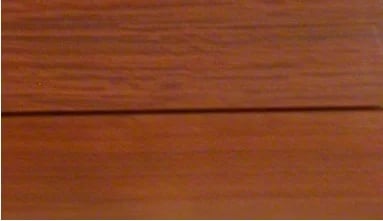
Mataverde® Premium Ipe Hardwood is the ultimate decking solution for the discriminating user who wants a beautiful all-natural wood product that will last for decades. When people ask, "what is the best material for a deck board?", Ipe is often the best answer. Mataverde Ipe wood is available in many board sizes, from 1x4 to 5/4x12 and everything in between.
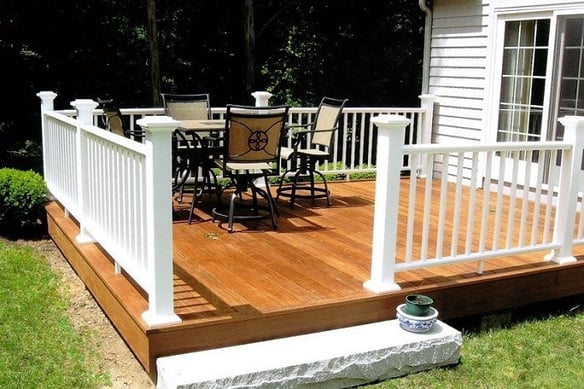 With Ipe wood there will be a full spectrum of color ranges from tan to olive brown to reddish to dark browns. The exotic graining and "striping" will differentiate every piece of Ipe decking. Like a hardwood floor, no two pieces of Ipe are exactly alike.
With Ipe wood there will be a full spectrum of color ranges from tan to olive brown to reddish to dark browns. The exotic graining and "striping" will differentiate every piece of Ipe decking. Like a hardwood floor, no two pieces of Ipe are exactly alike.
The character marks and naturally distinguishing coloration and graining variegation are inherent in all wood species. Some species exhibit more character than others. Mataverde® Premium Ipe is one such spectacular species.
Allow your deck to silver? Or preserve the warm tones? Ipe is beautiful either way.
|
|
|
|
Natural weathering of Ipe hardwood decking develops a silvery patina making it a low maintenance choice for decking. |
A rosewood oil finish on your Ipe deck darkens and enhances the rich colors and natural graining of Ipe hardwood. |
There is more great information for you in the links below:
Learn More About Ipe Decking here
View the Mataverde Ipe Photo Gallery for more inspiration
How Does Ipe hardwood compare to other decking options?
Ipe hardwood is an all natural sustainable decking material that totally outshines virtually all other decking material options, wood decking, composite decking, plastic decking, and more in nearly every measurable performance rating. Ipe is often called the best decking wood available.
See how Ipe compares to Red Cedar and other wood decking options here.
See how Ipe compares to Composite decking and other Synthetic decking material options here.
How Does Ipe hardwood decking compare to Redwood decking?
How Does Ipe compare to Garapa Decking?
How Does Ipe compare to Cumaru Decking?
Compare Ipe pricing to other decking materials
Ready to get a quote for your decking project? Request pricing here.
HARDWOOD DECKING MATERIALS:
Mataverde Cumaru Decking
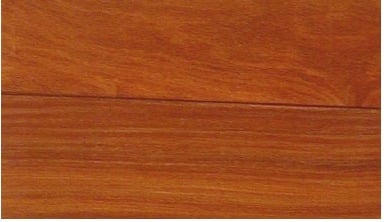
Mataverde® Premium Cumaru Hardwood is all heartwood and ranges in coloration from a yellowish brown to reddish browns to a nearly purplish cordovan color that is spectacular.
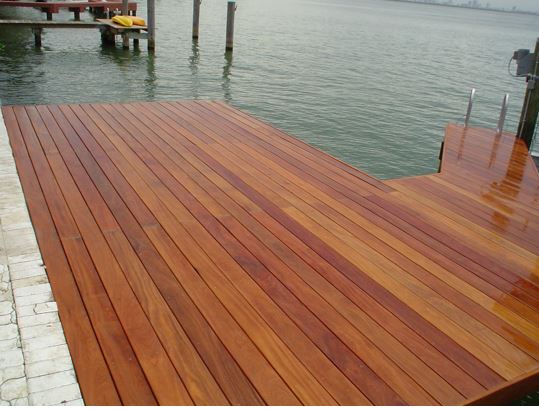 Although the coarse graining of Cumaru decking may appear similar to oak, the exotic color range and natural characteristics make it unique. Cumaru's distinctly dramatic and beautiful qualities are one of the reasons it is so popular as a long-lasting decking material.
Although the coarse graining of Cumaru decking may appear similar to oak, the exotic color range and natural characteristics make it unique. Cumaru's distinctly dramatic and beautiful qualities are one of the reasons it is so popular as a long-lasting decking material.
Like a hardwood floor inside your home, no two pieces of Cumaru decking are alike. This rich variegation of Cumaru reflects the untamed beauty of this spectacular, responsibly harvested, all-natural wood decking species.
More information and inspiration for you at these links:
Learn More About Cumaru Decking
View the Cumaru Decking Photo Gallery
How Does Cumaru hardwood compare to other decking options?
Cumaru hardwood is an all natural sustainable decking material that outshines lower quality material options like softwood decking, composite decking, plastic decking, and more in nearly every measurable performance rating.
See how Cumaru compares to Red Cedar and other wood decking options here.
See how Cumaru hardwood decking compares to Composite decking and other Synthetic decking material options here.
Compare Cumaru pricing to other decking material pricing
HARDWOOD DECKING MATERIALS:
Mataverde Garapa Decking
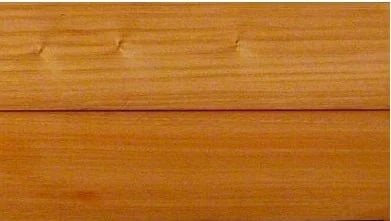
Mataverde® Garapa High Density Hardwood is all heartwood and its colors range from sun-kissed yellow to golden-brown. Its soft ribbon-like graining is reminiscent of maple or mahogany, and it possesses a slightly more uniform color and graining than Ipe or Cumaru decking. Its colors will darken slightly with time, weathering to a lovely silvery gray. To preserve its warm hues, coat annually with a rose-oil sealant such as Penofin.
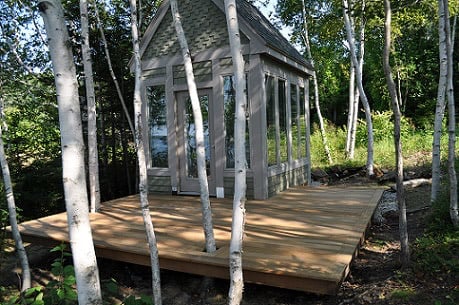 Garapa decking is extremely resistant to shrinking, splintering, twisting, cupping, fire and insect damage - much like Mataverde® Ipe and Cumaru decking. From a durability standpoint, Garapa wood is extremely hard and tough and will resist most types of punishment.
Garapa decking is extremely resistant to shrinking, splintering, twisting, cupping, fire and insect damage - much like Mataverde® Ipe and Cumaru decking. From a durability standpoint, Garapa wood is extremely hard and tough and will resist most types of punishment.
Like a hardwood floor inside your home, no two pieces of Garapa decking are alike. Each Garapa deck board showcases this species' diverse color range and graining patterns. Garapa's all-natural beauty is what differentiates is from factory-made decking materials and makes it a perennial favorite for residential and commercial decking projects alike.
Find lots more information and ideas for Garapa Decking at these links:
Learn More About Garapa Decking
View the Garapa Decking Photo Gallery
How Does Garapa hardwood compare to other decking options?
Garapa hardwood is an all natural sustainable decking material that is the most affordable option of premium hardwood decking options.
See how Garapa hardwood compares to Red Cedar and other wood decking options here.
See how Garapa compares to Synthetic decking material options here.
How Does Garapa wood compare to Composite decking?
How Does Garapa compare to Ipe Decking?
Compare Garapa pricing to other decking material pricing
HARDWOOD DECKING MATERIALS:
Mataverde® FSC® Machiche Decking
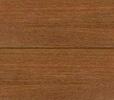
Mataverde FSC Machiche is a high-density and durable decking material that is acknowledged by LEED as an FSC-approved green building material. Naturally resistant to shrinking, splintering and insect damage, Mataverde FSC Machiche is a beautiful and affordably priced decking material that adds sophistication and longevity to any design.
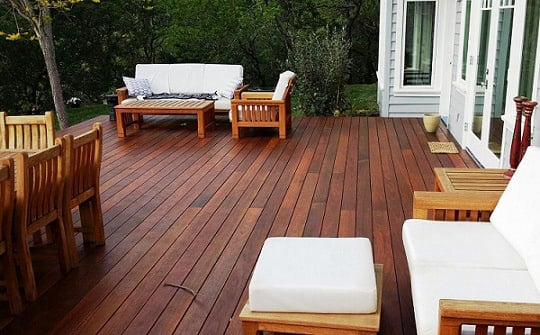 Mataverde FSC Machiche boards are all heartwood and exhibit medium graining, with colors ranging from light brown to reddish brown and medium chocolate brown. Like Ipe wood, Machiche decking will age gracefully to a mellow silvery patina if left to weather naturally. With a coat of rosewood oil penetrating sealer, Machiche decking develops a rich chocolate coloration.
Mataverde FSC Machiche boards are all heartwood and exhibit medium graining, with colors ranging from light brown to reddish brown and medium chocolate brown. Like Ipe wood, Machiche decking will age gracefully to a mellow silvery patina if left to weather naturally. With a coat of rosewood oil penetrating sealer, Machiche decking develops a rich chocolate coloration.
Affordably priced, tough as nails, and environmentally friendly, Machiche offers an affordable decking material that is sophisticated and long-lasting.
Need more information? There's more to learn about Machiche in the links below:
Learn More About Machiche Decking
View the Machiche Decking Photo Gallery
How Does Machiche hardwood decking compare to other decking options?
Machiche hardwood is an all natural sustainable decking material that is a beautiful, more durable and all around higher quality option that many other wood species, composite and plastic decking, and many others in nearly every measurable performance rating.
See how Machiche decking compares to Red Cedar and other wood decking options here.
See how Machiche hardwood compares to Composite and Synthetic decking material options here.
How Does Machiche wood compare to Mahogany decking?
How Does Machiche decking compare to Ipe wood?
Compare Machiche pricing to Other decking material pricing
SOFTWOOD DECKING MATERIAL OPTIONS:
"Pressure Treated" Southern Yellow Pine
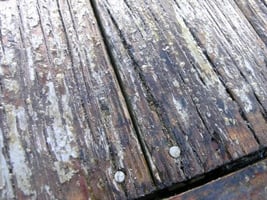
In the 1970's, the "next big thing" to hit the market was "pressure" treated lumber. In this process, heavy metals and other toxins are injected into the grains of the wood under high pressure. This chemically enhanced product rapidly gained acceptance during the 1980's. It was readily available, fairly inexpensive to buy, easy to work with and with all the chemical additives many manufacturers initially boasted a "lifetime warranty".
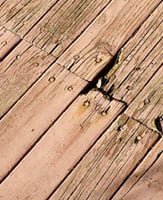 It became immediately apparent that despite its excellent fiber strength, southern yellow pine had a number of bad habits. The species has a tendency to cup, warp, split, twist, crack and check - especially on pieces that were milled poorly. Splinters were also a common concern. Over the next few years it became evident that in addition to containing harmful toxins and carcinogens, the pressure-treated Southern Yellow Pine didn't actually "last a lifetime" as initially claimed.
It became immediately apparent that despite its excellent fiber strength, southern yellow pine had a number of bad habits. The species has a tendency to cup, warp, split, twist, crack and check - especially on pieces that were milled poorly. Splinters were also a common concern. Over the next few years it became evident that in addition to containing harmful toxins and carcinogens, the pressure-treated Southern Yellow Pine didn't actually "last a lifetime" as initially claimed.
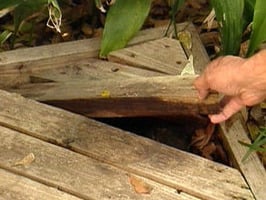 Many "treaters" went out of business in the wake of this revelation. Most of the remaining manufacturers reduced their warranties and included scores of disclaimers in their revised "limited" warranties.
Many "treaters" went out of business in the wake of this revelation. Most of the remaining manufacturers reduced their warranties and included scores of disclaimers in their revised "limited" warranties. RELATED: Learn More About Ipe Decking Vs. Pressure Treated Decking
How Does Pressure Treated decking compare to hardwood decking options?
Hardwood decking is an all natural sustainable decking material that is a beautiful, more durable and all around higher quality option that many other softwood decking species, composite decking, plastic decking, and more in nearly every measurable performance rating.
See how Pressure Treated decking compares to Other wood decking options here.
How Does Hardwood decking compare to Composite decking?
How Does Pressure Treated decking compare to Ipe Decking?
Compare Pressure Treated decking pricing to Other decking material pricing
SOFTWOOD DECKING MATERIAL OPTIONS:
California Redwood Decking
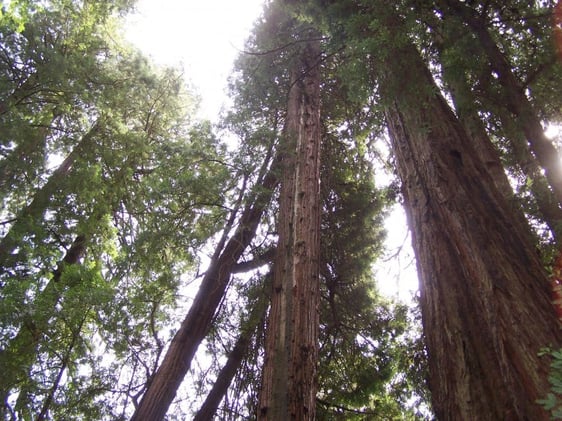
For years California Redwood was hailed as the best decking material available. In addition to being long-lasting, stable and easy to work with, it was plentiful and readily available - albeit a little pricey.
Over time, supply sources dwindled and the high-quality heartwood became less available. Prices rose dramatically, as a result.
With a coat of sealer or preservative applied yearly California Redwood lasted a fairly long time and remained attractive. Without routine maintenance, California Redwood is apt to turn black.
How Does Redwood decking compare to other decking options?
Compared to other woods, Hardwood decking is an all natural sustainable decking material that is a beautiful, more durable and all around higher quality option that many other wood decking, composite decking, plastic decking, and more in nearly every measurable performance rating.
See how Redwood decking compares to Other wood decking options here.
How Does Redwood decking compare to Ipe Decking?
Compare Redwood decking pricing to Other decking material pricing
DOWNLOAD THE FINISHING OPTIONS GUIDE FOR DECKING SIDING HERE
SOFTWOOD DECKING MATERIAL OPTIONS:
Western Red Cedar Decking
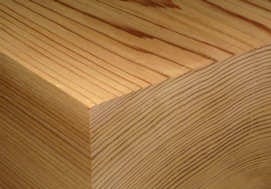
These market conditions increased the appeal of Western Red Cedar. Once considered the "poor man's redwood", Red Cedar continued to grow in popularity.
Like the Redwood scarcity before it, as product availability and quality concerns increased the prices followed.
Many consumers who sought an affordable decking surface were forced to use lower grades of red cedar to meet their decking budgets.
For a softwood species, Red Cedar typically holds up fairly well providing consumers with at least a decade of usage, as long as you keep it finished with a proper stain or sealer. It is relatively stable and easy to work with. Maintenance includes an annual maintenance coat of a preservative or stain to prolong its lifespan.
How Does Red Cedar decking compare to other decking options?
Compare softwood Red Cedar decking to premium hardwood decking, an all natural sustainable decking material that is a beautiful, more durable and all around higher quality option that many other wood deckings, composite decking, plastic decking, and more in nearly every measurable performance rating.
See how Red Cedar hardwood decking compares to Other wood decking options here.
How Does Red Cedar decking compare to Ipe Decking?
Compare Red Cedar decking pricing to Other decking material pricing
SYNTHETIC DECKING MATERIAL OPTIONS:
"Composite Decking"
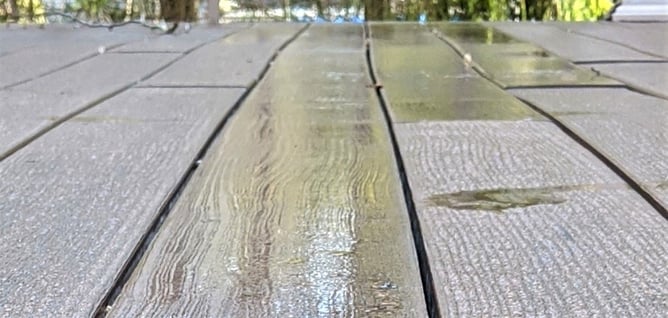
The poor performance of pressure-treated lumber decking and the high cost of the alternative wood decking products left a void for consumers. Enter "composite decking material" in the 1990's.
Since the early days, scores of manufacturers have jumped on the bandwagon to attempt to find a synthetic decking material that looks like real wood and behaves appropriately. "Composite" decking material - typically a mixture of finely ground sawdust and plastic designed to appear like real wood decking - seemed to fill the bill.
|
|
|
|
The first generation of "composite decking" was expensive and performed poorly; problems with the decking materials' weakness, appearance, softness and rotting were abundant. The complaints led to multiple lawsuits and at least one class action suit was settled out of court with one manufacturer so the results were not revealed to the public.
Composite decking manufacturers quickly removed erroneous claims from their advertising including "maintenance free" promises and "lifetime warranties". Most composite decking products will 'ugly out' before they actually wear out.
How Does Composite decking compare to other decking options?
Compare Composite decking to all natural hardwood decking, sustainable decking material that is a beautiful, more durable and all around higher quality option that many other wood deck materials, composite decking, plastic decking, and more in nearly every measurable performance rating.
See how Composite decking compares to premium Hardwood decking species:
Composite decking vs. Ipe decking
Composite decking vs. Machiche decking
Composite decking vs. Cumaru decking
Composite decking vs. Garapa decking
Compare Composite decking pricing to Other decking material pricing
OTHER DECKING MATERIAL OPTIONS:
Philippine "Mahogany" Decking (Shorea spp.)
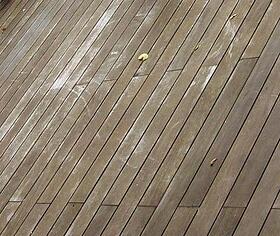
The so-called "mahogany" decking that has permeated the US market in the last two decades or so, is actually not a true mahogany at all. There are actually many different subspecies of the Shorea species.
These subspecies range wildly in color, graining, work-ability, stability and marginal durability. The soft surface scratches and dents easily. The open grain is susceptible to mold and mildew. Wormholes are a common defect and the species show little resistance to decay and termite resistance.
Need help deciding on the right decking material?
Download the "Ultimate Guide to Selecting The Right Decking" now, free.
Ready for a price? Request a Decking Quote here.
How Does Mahogany decking compare to other decking options?
Compare Philippine "Mahogany" decking to premium Hardwood, an all natural sustainable decking material that is a beautiful, more durable and all around higher quality option to many other wood decking species, composite decking, plastic decking, and more in nearly every measurable performance rating.
See how Mahogany Hardwood decking compares to real premium Hardwood decking material options here.
How Does Machiche hardwood decking compare to Mahogany decking?
How Does Ipe hardwood decking compare to Mahogany Decking?
Compare Mahogany decking pricing to Other decking material prices.
Ready for more? Download your "Ultimate Guide to Selecting The Right Decking Material" free, now
for all the information you need on hand.
Want pricing for your deck project? Request a quote, we're here to help.
Choose Mataverde Decking as your choice for top quality hardwood decking supply.


